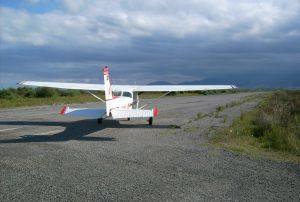Small Plane Crashes an Autumn Risk in Alabama
Sep 25, 2012 - Personal Injury by Cross & Smith
A rash of small plane accidents in Alabama has authorities concerned as we enter the autumn flying season.
General aviation enthusiasts like to say flying is as safe as driving. While that might be true for flying commercial, it’s patently false when it comes to general aviation. Small plane flight is comparable in risk to riding a motorcycle. That is to say, quite dangerous. In fact, the Airplane Pilot and Owner’s Association (AOPA) reports more than 1,200 general aviation accidents occur annually. In 2009, the FAA reports 475 of the nation’s 535 aviation fatalities occurred in the private aviation sector. Sixty-eight fatal Alabama plane crashes were reported from 2007-2009. 
A small plane crash killed two people Monday in Cullman County. The accident happened off Cullman County Road 174 near Smith Lake when a Mooney aircraft out of Destin, Florida crashed after the pilot radioed a report of difficult weather conditions and issued a Mayday call. An accident on Saturday involving a seaplane claimed the life of a man on Weiss Lake in Cherokee County. Two others were also killed on Saturday when their World War II era plane crashed in Madison County at the Moontown Grass Field Fly-in.
Our Tuscaloosa personal injury attorneys know that autumn is the most dangerous time of the year for airplane accidents in Alabama. Hundreds of pilots stop in Alabama en route to Florida, which is the private aviation capital of the United States. Icing is often a threat in the fall, even when temperatures are more moderate nearer the surface. Most small planes can become unstable in just minutes when icing conditions are present.
And, as winter approaches and the atmosphere becomes more volatile, small aircraft may faces a host of weather-related risks, including thunderstorms, hail, updrafts and downdrafts, high winds and low visibility.
These are complex cases. The National Transportation Safety Board reports airplane accidents are most often the fault of the pilot. In fact, 4 of the top 5 causes are attributable to pilot error, including loss of flight control, loss of control on the ground, improper landing and poor fuel management.
Poor weather is another common cause — particularly visual flight into instrument meteorological conditions or VFR (visual flight rating) in IMC (instrument meteorological conditions). Pilots must receive advanced training to fly by instruments in clouds or other low-visibility conditions. When they ignore the rules, or fail to receive the proper training, flying in instrument conditions is a leading cause of fatal weather-related accidents.
Pilots must also maintain currency twice a year once achieving Instrument Flight Rating (IFR). All pilots must also maintain night currency and be experienced in the aircraft they are flying before making flights with passengers are permitted.
Airplanes have specific maintenance and overall requirements, including an annual (which typically costs $3,000 to $5,000 for a small plane) and a mandatory rebuild ($20,000), usually every 2,000 hours. When owners neglect their maintenance obligations, serious or fatal crashes may result.
Each pilot must also maintain an active medical certification — which includes an electrocardiogram and physical every six months for ATP (Airline Transport Pilots) and a physical every 1-5 years for other commercial and private pilots, depending on status and age.
Additional Resources
Three small plane crashes in 3 days claim 5 lives in North Alabama, By The Huntsville Times, Sept. 18, 2012.
Root for the Home Team Responsibly – Reduce Risks of Drunk Driving Accidents in Alabama, By Cross & Smith, LLC, Sept. 14, 2012.

